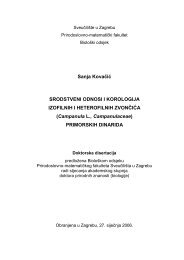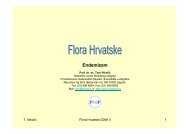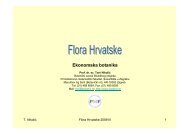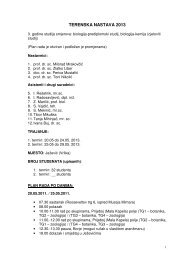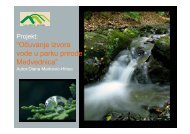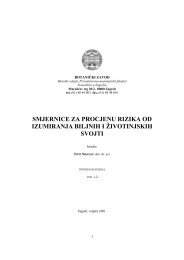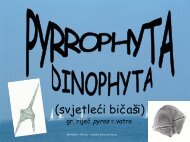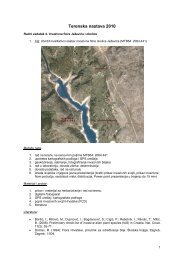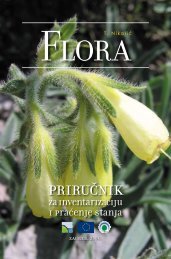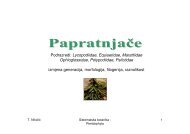important plant areas in central and eastern europe - hirc.botanic.hr ...
important plant areas in central and eastern europe - hirc.botanic.hr ...
important plant areas in central and eastern europe - hirc.botanic.hr ...
You also want an ePaper? Increase the reach of your titles
YUMPU automatically turns print PDFs into web optimized ePapers that Google loves.
Summary of IPA dataDamag<strong>in</strong>g forestry practises, which <strong>in</strong>clude <strong>in</strong>tensified forest management, afforestation<strong>and</strong> deforestation, t<strong>hr</strong>eaten almost half of IPAs.The t<strong>hr</strong>eat to IPAs from <strong>in</strong>vasive speciesalso comes <strong>in</strong> part from exotic trees species that take over exist<strong>in</strong>g forest habitats.Protection of forest IPAs <strong>and</strong> control of damag<strong>in</strong>g forestry practices must be a highpriority for future conservation action at IPAs.Tourism <strong>and</strong> recreation development is the second most widespread t<strong>hr</strong>eat to IPAs.Thet<strong>hr</strong>eat comes not only from facilities <strong>and</strong> <strong>in</strong>frastructure but also from exceed<strong>in</strong>g carry<strong>in</strong>gcapacity on nature trails <strong>and</strong> paths.Tourism is a powerful tool for rais<strong>in</strong>g awarenessabout nature <strong>and</strong> conservation, but needs to be developed with local l<strong>and</strong> managers <strong>and</strong>specialists to prevent the destruction of priority sites.Agricultural <strong>in</strong>tensification or expansion (graz<strong>in</strong>g, mixed agriculture <strong>and</strong> arable) t<strong>hr</strong>eatensalmost one third of IPAs. L<strong>and</strong> ab<strong>and</strong>onment affects over a quarter of IPAs. Raregrassl<strong>and</strong> habitats are particularly vulnerable to ab<strong>and</strong>onment of graz<strong>in</strong>g or mow<strong>in</strong>gregimes.Agri-environment schemes <strong>and</strong> Rural Development Programmes have thepotential to save both <strong>important</strong> grassl<strong>and</strong> habitats <strong>and</strong> the local communities thatma<strong>in</strong>ta<strong>in</strong> them, if local, national <strong>and</strong> EU policy makers support <strong>and</strong> recognise theimportance of a healthy, t<strong>hr</strong>iv<strong>in</strong>g countryside.Transport <strong>and</strong> urban development t<strong>hr</strong>eaten one quarter of priority <strong>plant</strong> sites. National<strong>and</strong> EU transport planners <strong>and</strong> funders have the necessary <strong>in</strong>formation to avoiddestroy<strong>in</strong>g priority sites yet even some Natura 2000 sites with a high level of protectionare t<strong>hr</strong>eatened by transport projects.The EU <strong>in</strong> particular has a responsibility to ensurethat structural funds used for transport networks such as TEN-T do not destroypriority sites <strong>and</strong> contradict its commitments to biodiversity conservation.A high number of IPAs are t<strong>hr</strong>eatened by damag<strong>in</strong>g water management practices such asdra<strong>in</strong>age, canalisation, <strong>and</strong> extraction.Wetl<strong>and</strong>s, <strong>in</strong>clud<strong>in</strong>g peatl<strong>and</strong>s, are one of the mostt<strong>hr</strong>eatened <strong>and</strong> rapidly disappear<strong>in</strong>g habitats <strong>in</strong> Europe.A significant number of IPAs arealso t<strong>hr</strong>eatened by eutrophication or nutrient pollution, which often results fromagricultural or <strong>in</strong>dustrial discharge <strong>in</strong>to water systems. Damage to wetl<strong>and</strong> ecosystemsdestroys not only the wetl<strong>and</strong> sites themselves but also the many other habitats whic<strong>hr</strong>ely on these ecosystems.The EU Water Framework Directive can be used to preventwater pollution <strong>and</strong> also to ma<strong>in</strong>ta<strong>in</strong> the ecological status of <strong>important</strong> wetl<strong>and</strong> sites.Ownership <strong>and</strong> l<strong>and</strong> useAlmost half of IPAs are owned by state organisations (state 364 (46%), municipal 24(3%), military 7 (1%)). Many IPAs are also privately owned (private 187 (23%), religiousgroups 8 (1%)), <strong>and</strong> 69 (9%) are communally owned. 16 (2%) are owned by conservationorganisations, <strong>and</strong> just over 10% of IPAs have mixed ownership or the ownership isunknown.29



